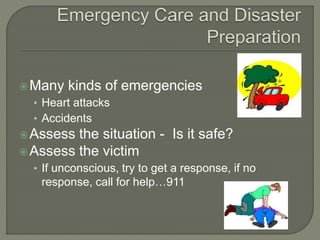
Chapter 7. Emergency Care and Disaster Preparation
- 1. Many kinds of emergencies • Heart attacks • Accidents Assess the situation - Is it safe? Assess the victim • If unconscious, try to get a response, if no response, call for help…911
- 2. Always get help, Call the nurse Stay with the resident Start CPR, if necessary, until help comes, and they take over If you witness someone go unconscious, note the time. This will be important for documentation
- 3. Assess the situation • Safe • Resident: conscious or unconscious –” Are you ok?” • Breathing? Heart beat? • Look, listen, and feel Start CPR, if needed • Latest guidelines indicate priority is chest compressions. • No circulation leads to brain damage and death
- 4. Definition: Obstructed airway • Airway is blocked, person can’t breathe • If person can cough or speak, they do not have an obstructed airway…”are you choking?” If yes, then… • Call light, yell out for help, do not leave resident • 5 sharp back blows, abdominal thrusts – Heimlich Maneuver • Continue until airway clears or person unconscious • Report and document
- 5. Definition: • Decreased blood flow to organs Cause: • Heart attack, injury, severe infection • Dangerous, life-threatening emergency Signs: • Pale or bluish skin color • Rapid pulse and respirations • Low blood pressure (suddenly)
- 6. Call for help!! Have person lie down on back; this raises the blood pressure If bleeding from mouth, place on side to avoid choking Control bleeding (pressure) Remain calm, keep resident calm Elevate feet unless head or abdominal injury, breathing problems, or fractured bone or back. Elevate head and shoulders if breathing problems or head wound. Report and document.
- 7. Definition: • Heart muscle not getting enough oxygen because of blocked blood vessel Signs: • Sudden chest pain • Jaw pain, arm pain, neck or back pain, chest pressure • “Indigestion” or heart burn feeling • Nausea, vomiting, breathing difficulty (dyspnea) • Pale, cold, clammy skin
- 8. Call for help!! Loosen clothing, encourage rest Reassure Do not give liquids or food Stay with resident Report and document
- 9. Put on gloves…take the time to do this. Bleeding must be controlled…loss can be life-threatening Apply pressure with towel, thick pad, until help arrives Raise wound above heart level, if able Stay with resident until help arrives Report and document
- 10. Notify the nurse Check for bottle or container to indicate what resident has eaten or taken Poison control Report and document
- 11. 3 types of burns: • 1st degree: just outer layer of skin Red, painful, swollen, no blisters • 2nd degree: Injury extends to next layer of skin Red, painful, swollen, blisters • 3rd degree: all 3 layers of skin Injury may extend to bone Nerves destroyed, no pain Skin may appear white, shiny, hard
- 12. Minor burn (1st degree) • Cool water, not ice, prevents further injury • Dampen cloth and place over area • May cover with sterile gauze • No ointment More serious burns: • Remove resident from burn source • Call for help • Check for breathing problems or rapid pulse • Do not apply water • Cover burn with sterile gauze, if available • Have person lay down and elevate affected part if does not cause further discomfort • Stay with resident until help arrives
- 13. • Caused by decreased blood flow to brain Symptoms before fainting: • Dizzy, pale, weak pulse What to do? • Have person lie or sit down before faints • Bend forward, put head between knees • If flat, elevate legs
- 14. Loosen tight clothing Stay with person until help comes Report and document If fainting occurs: • Lower to floor or position on back • Call for help • Elevate legs • Loosen tight clothing • Check to make sure breathing • Report and document
- 15. Have person sit up, lean forward Gloves Firm pressure over bridge of nose Tell nurse Report and document
- 16. Hypoglycemia – low blood sugar • Too much insulin or too little food (see handout) Symptoms: • Dizziness, sweating, confusion, feels shaky, headache, cold clammy skin What to do? • Give food, orange juice
- 17. Caused by abnormality in brain Can be result of high fever What to do? • Call nurse • Keep resident safe, provide pillows under head, lay on side, prevent injury • Do not place hands in mouth or put anything between teeth of resident • Stay with resident until seizure if over • Report and document
- 18. Warning sign of impending stroke Temporary lack of oxygen to brain Symptoms • Facial droop, sudden weakness, numbness, slurred speech, headache What to do? • Tell nurse right away. If in resident’s home, call 911
- 19. May be specific to area of country Tornados, hurricanes, lightning storms, floods, blackouts Need to become familiar with disaster protocols of facility and region